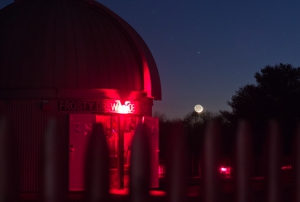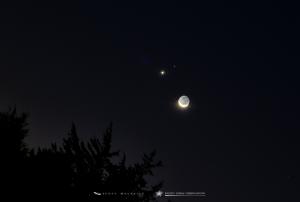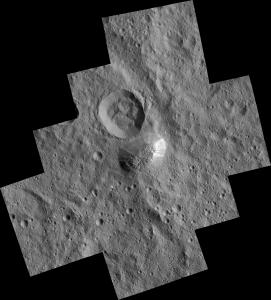
Stargazing Night
- Where:
- Frosty Drew Observatory
- When:
- Friday March 11, 2016 at 6:30 p.m.
- Cost:
- $1 Suggested Donation per Person
Tonight is Stargazing Night at Frosty Drew Observatory and what a perfect night it is! The forecast looks awesome, with clear skies and calm winds expected all night long. The super thin 12% waxing crescent Moon will be with us at sunset and will stick around until about 9:00 p.m. offering up fabulous views of the Earth-shined crescent hanging softly in the west. Following moonset, the skies will remain super dark, blazing with stars. Add in that Jupiter will be visible all night long and tonight is set to be the best night of 2016 yet.
We will open the Observatory and Sky Theatre at 6:30 p.m. In the Observatory, telescopes will start with a showcase of the fabulous 12% crescent Moon. Once twilight begins to wane, we will direct our telescopes towards Jupiter, showcasing the four Galilean Moons, equatorial bands, and the Great Red Spot later in the night. As the night progresses, an impressive list of star clusters, nebulae and galaxies will be on display. In the Sky Theatre we will feature our popular showcase of celestial objects photographed at Frosty Drew. Temps will be in the mid 30's tonight, certainly a departure from the spring-like temps of these last couple days, so dress for winter! We will stay open tonight quite late, closing up no earlier than midnight. Check in with our Twitter (@FrostyDrewOBSY) or Facebook before setting out as we post a "Closing up" message when we decide to pack it in.
Overall, tonight looks amazing. Clear skies, super thin crescent Moon, early moon set, super dark skies, Jupiter near opposition, Milky Way rising in early morning; awesome things happen on these nights. If you have been debating a visit or thinking about taking the long drive to Charlestown, RI; well tonight is your night. So grab the winter garb, friends and family, and set out for a your moment of astonishment under the fabulous starscape at Frosty Drew.
-------------------------------------------------------------------------
Weekly Happenings
Scott MacNeill
Have you ever sat out mesmerized by the beautiful crescent Moon and noticed that the shadow side of the Moon is dimly visible along side the bright crescent? Well this is not all that uncommon and happens whenever the Moon is in a crescent phase. This happening is called “Earth-shine” and is a result of sunlight reflecting off of Earth and onto the entire side of the Moon facing Earth. This happens all the time, though the visible area of the Moon in direct sunlight will eventually over-power the affects of Earth-shine, making it invisible to us until the Moon wanes enough for it to become visible again. The best times to catch Earth-shine is about 60 minutes after sunset or before sunrise when the Moon's crescent phase is around 10% - 20% illuminated, like tonight.
Remember that amazing little spacecraft that visited two Solar System objects? The NASA Dawn spacecraft is the what I'm talking about and it proved to the world how awesome our understanding of physics is while showcasing an elegant piece of engineering prowess. Dawn spent time orbiting both proto planet Vesta and dwarf planet Ceres in the Asteroid Belt. The mission remains at Ceres, where it will become a permanent resident. Check out some of the amazing images of Ceres captured by Dawn.
Now that winter is on the out, our minds shift to springtime thinking including early flower blooms, late sunsets, warm temps and bunnies. Though the hardened astro-geek passes these things over, preoccupied with thoughts of galaxies! The springtime starscape brings a region of galaxy awesomeness to our Northern Hemisphere view identifiable inside a triangle of sky bordered by the bright stars Denebola in Leo, Vindemiatrix in Virgo and the Coma Star Cluster in Coma Berenices. Inside this area is where we find the Virgo Supercluster, a cluster of about 100 galaxy groups including the Local Group, which is where we reside. In mid-late February, the Virgo Supercluster becomes accessible to the Frosty Drew telescopes, with each consecutive night offering earlier visibility. Add in that the spectacularly bright Milky Way starts rising in the early morning and it becomes apparent why the springtime is the best time to be out under the stars at Frosty Drew.
-Scott



